Atlas Trainman PS-2 Covered Hopper
Published: 2024-09-01 - By: CNW400
Last updated on: 2024-08-15
Last updated on: 2024-08-15
visibility: Public - Headline
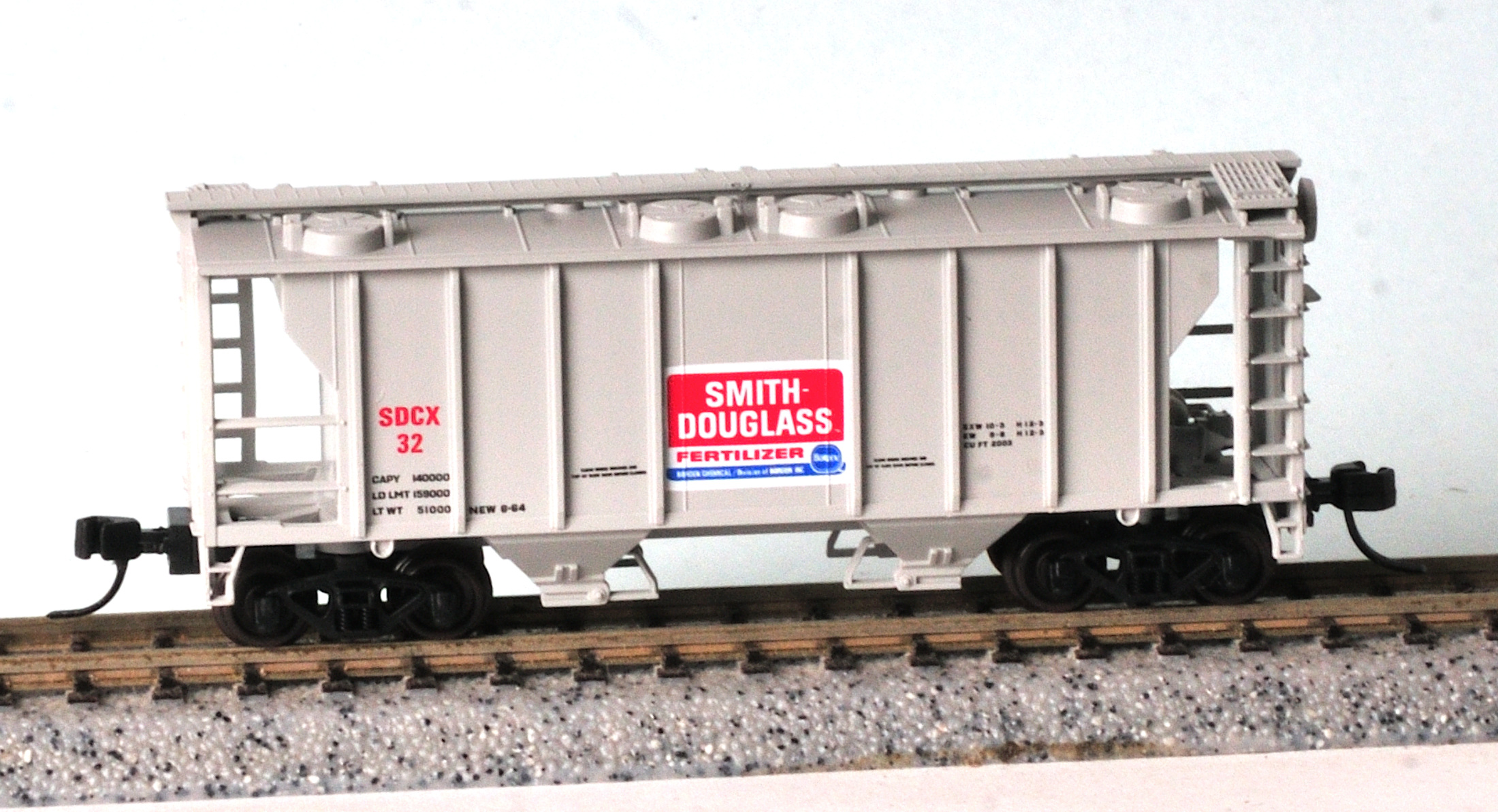
The Borden Company
When you hear the name Borden, the first images in your mind may be a glass of milk. Or perhaps a slice of cheese. And many of us remember and adore the official Borden Dairy mascot Elsie the Cow since her introduction in 1936. But besides being a leading brand in the dairy and food industries for over 140 years, Borden, Inc. was a giant in the plastic and chemical sectors.
Gail Borden Jr. founded his Connecticut-based condensed milk business in 1857. After a sluggish start, Borden prospered during the American Civil War (1861-1865) supplying his condensed milk to Union troops. After the War, Borden became a dairy pioneer selling processed milk in 1875 and utilizing reusable glass bottles in 1885. His company grew into the largest United States producer of dairy and pasta products under the Borden, Meadow Gold, and Creamette brand names.

During the early 1950s, Borden ventured into the plastic and chemical industries – becoming a leader in adhesive, resin, printing ink, fertilizer, petroleum, and polyvinyl chloride plastic (PVC) trades. The Borden Chemical Company manufactured such household products as Elmer’s and Krazy Glue adhesive brands. The subject of my review…the Smith-Douglass Company was a Norfolk, Virginia fertilizer producer that was purchased by the Borden Chemical Company in 1964 in a stock exchange worth nearly $80 million.
Borden, Inc. experienced financial struggles in the 1990’s with a shift in consumer preferences, rising production costs, and significant debt on the books. Private equity firm Kohlberg Kravis Roberts (KKR) took control of Borden in 1995 and began to divest their chemical divisions and shut down food production in 2001 with the expectation of Borden milk and cheese. The milk division reorganized as Borden Dairy Company in 2009 as a subsidiary of Dean Foods. Once again, Borden feel into financial troubles and filed Chapter 11 bankruptcy in January 2020 citing reduced sales and rising debt. New Dairy Opco LLC purchased the assets of Borden in June 2020 and since has been the owner of what is left to the Borden legacy.
The Prototype
George Pullman incorporated the Pullman Palace Car Company in 1867 with its first plants in Detroit and Elmira, New York. Pullman manufactured and operated luxury sleeping cars on most of the United States railroads. His company also produced streetcars and trolley buses.In 1929 Pullman gained controlling interest in the Standard Steel Car Company. The Standard Steel Car Company of Butler, Pennsylvania was established in 1902 and grew to become one of the leading steel car manufactures in the United States. In December of 1934, Pullman Car merged with Standard Steel Car to create the Pullman-Standard Car Manufacturing Company.

Based on the 1944 American Association of Railroads (AAR) industry standard, the PS-1 boxcar was produced from 1947 through 1968 and used for general merchandise, grain, and even coke & coal. Although the early models were riveted, most PS-1 cars featured welded construction. This standardization allowed for more free interchange amongst North American railroads.
Pullman-Standard further revolutionized the covered hopper design with the introduction of the PS-2 line during the late 1940s. Since covered hoppers were the second classification of rolling stock to be standardized by Pullman-Standard, all covered hoppers, with their different sizes and bay configurations, were assigned to the PS-2 designation.
The PS-2 2003 cubic foot was the amongst first and smallest standardized covered hoppers offered by Pullman-Standard. The hopper was produced with a fixed roof, sides, and ends. These welded, two-bay hoppers were 34-feet long with eight round loading roof hatches and bottom gravity outlet gates for quick load discharge. The gravity-controlled outlets had a plate covering their opening - once the plate was slid open with a crank - the load flowed out of the gates. The sides feature eight exterior support posts with three panels on both sides of an oversized center panel. Initially, the PS-2 hauled light, dry bulk products such as grain, sugar, and flour – but later were commonly found carrying the more dense, heavier commodities like cement, sand, and clay.
The Association of American Railroads (AAR) has designated the PS-2 2003cf covered hopper into Class LO / Type C111. Class LO refers to: “A permanently enclosed car, other than a box car, regardless of exterior or interior shape, for handling bulk commodities, with or without insulation and provided with openings for loading through top or sides with weather-tight covers or doors. Car may be provided with one or more bottom openings for unloading, with tight fitting covers, doors, valves, or tight-fitting slide or gate to prevent leakage of lading. Car may be provided with facilities for discharge of lading through openings in top or sides and may have one or more compartments. Mechanical or other means may be provided within car to expedite loading or unloading” - (Source: AAR). AAR Type C111 are simply covered hoppers of less than 3000 cubic feet.
The PS-2 hopper was fitted with an interior dividing wall, allowing for multiple products to be hauled at the same time – but most were used for single commodity service. Thus, some shippers were slow to accept the new freight car. Dry, bulk goods like cement and grains were packed into sacks and hauled in boxcars. These same boxcars could carry a different product on the return trip home – not empty like a single service covered hopper car. The time and labor saved utilizing a covered hopper versus a boxcar eased this apprehension.
Pullman-Standard began to produce larger capacity three-bay covered hoppers during the early 1950s – halting the manufacturing of the PS-2 2003 cubic foot two-bay hopper. But the prolific, little hopper continued to haul product well into the 2000’s and are often spotted today on Maintenance of Way (MOW) duty.
Road Names and Pricing
The Atlas Model Railroad Company has released the current tooling of the PS-2 Covered Hopper series nine times – the first run made public in February 2008. The Atlas PS-2 hopper is presently offered in their Trainman® product collection, which display less fine detail pieces and more molded parts for the price conscious modeler. The latest series was issued in March 2021 with nine different paint schemes:- Boston & Maine (Guilford)
- Burlington Northern (Scale Monitor Car)
- Central of Georgia
- Norfolk & Western
- Northern Pacific
- Penn Central
- Pennsylvania Railroad
- Smith-Douglass Fertilizer
- Undecorated
My review includes observations of Atlas Model Railroad: 50 005 901 - Smith-Douglass SDCX #32.
The Model
The ready-to-run covered hopper car is housed in a clear plastic jewel case with a slip-off cover and thin plastic sleeve wrapped around the model. The Atlas Trainman® collection further saves on packaging with a cheap, slim plastic cradle to support and protect your model car. Product information is clearly labeled on the end of the case.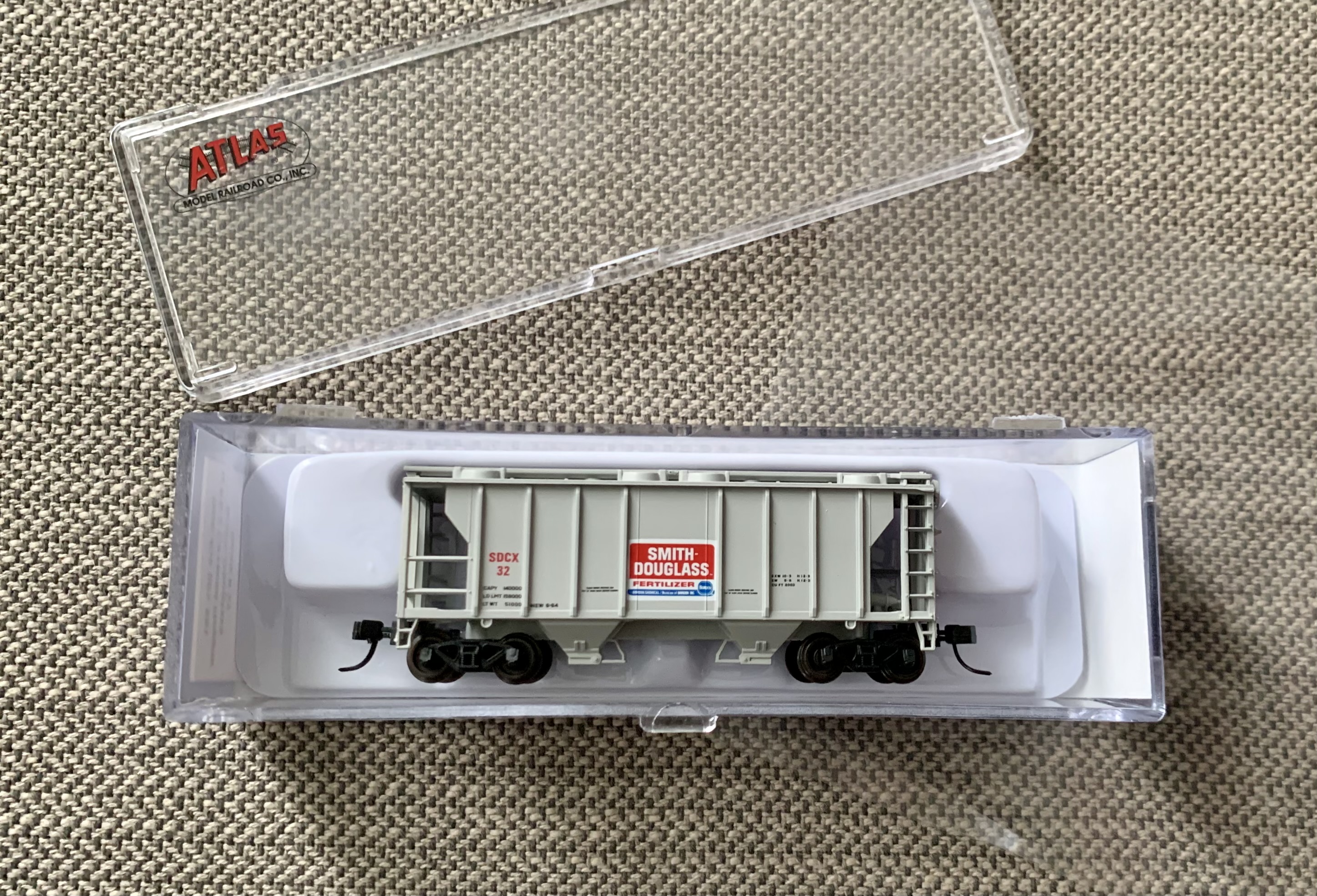
The light grey paint job is neat and clean with sharp black and red lettering. All lettering is bold and crisp, making it legible - without magnification. The Borden Chemical logo is displayed with the correct color pattern and size proportion as found on prototype SDCX hopper cars. The triangular gussets were affixed to the panel design atop the open platform ends to add structural support and make the hopper’s hauling capacity appear greater than its accommodation of 2003 cubic feet.
The sides further exhibit the PS-2 prototypical accurate seven panel configuration of three equal sized panels on both sides of a larger center panel. Whilst it displays the proper eight exterior post pattern – the posts nearest the end platforms are the incorrect shape. Those two posts should have a more concave contour found on real-life PS-2 2003 cubic feet cars, and the other six exterior posts have a more extruding composition. Furthermore, the end stirrups and six-rung full ladder are prototype appropriate – but have the appearance of being too bulky.
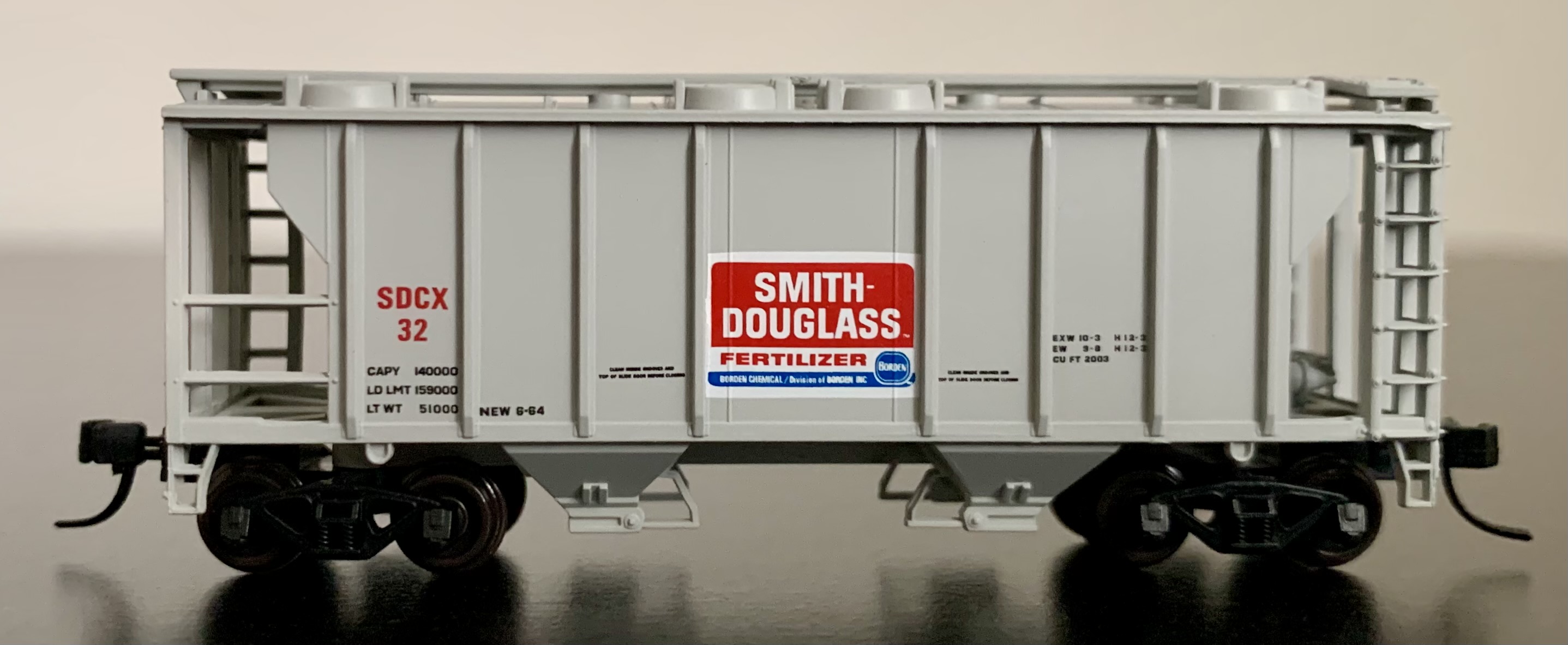
Both ends also feature thick, chunky-looking full height ladders and support posts – these structures appear a little too large for scale. The B-end displays a brake reservoir, cylinder, and control valve with molded chain and brake gear detail. A high-mounted standardized vertical hand brake and brake platform are present. Common modern brake wheels using during this era were made by Ajax, Equipco, Miner, and Peacock. With closer inspection – plastic molding ejector pin marks seen on the platform brake gear is rather unattractive. The lettering is neat and in proper the arrangement with the road marker & road number near the top right corner of each end. Some nice rivet work is noted on each end.
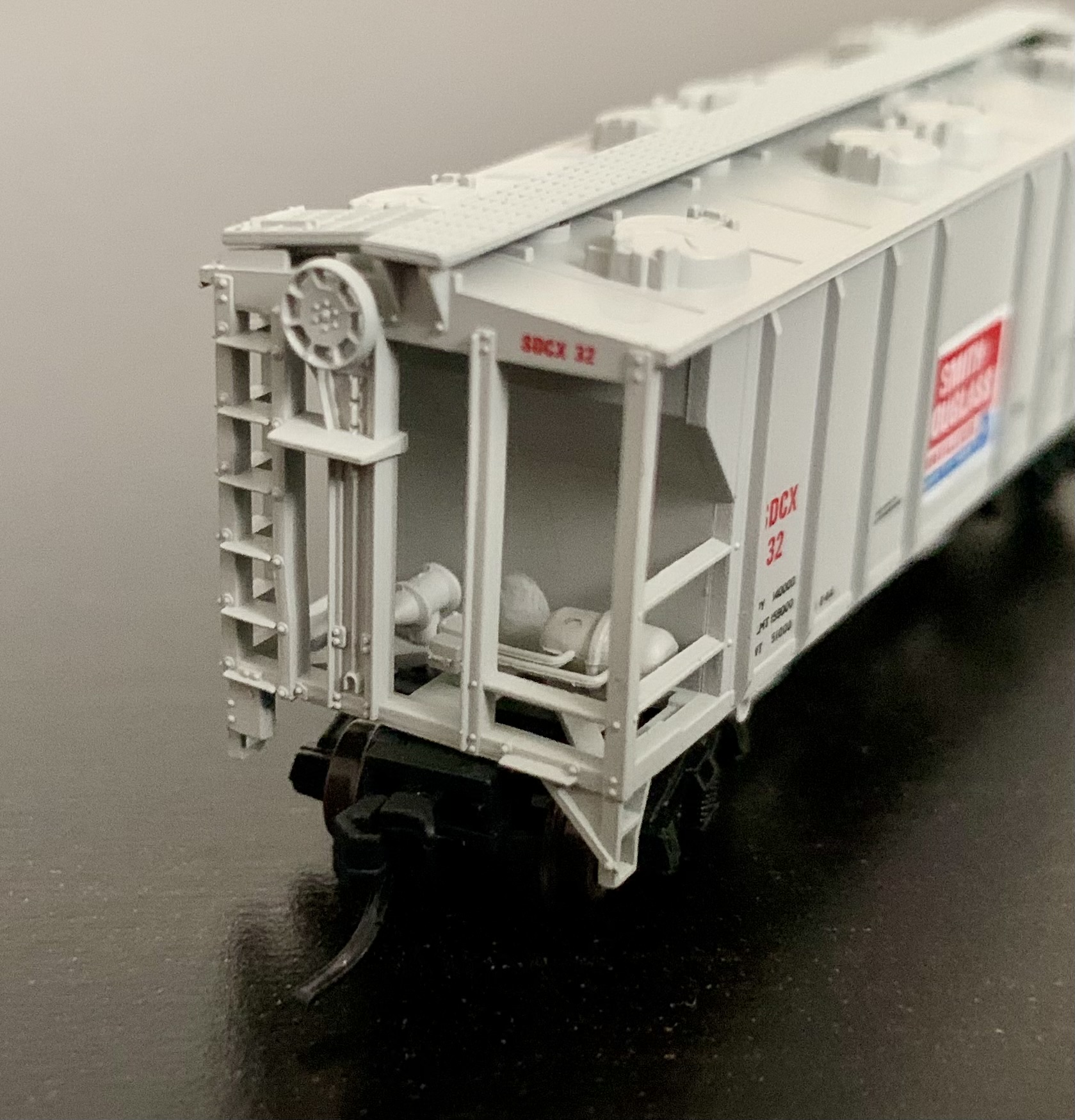
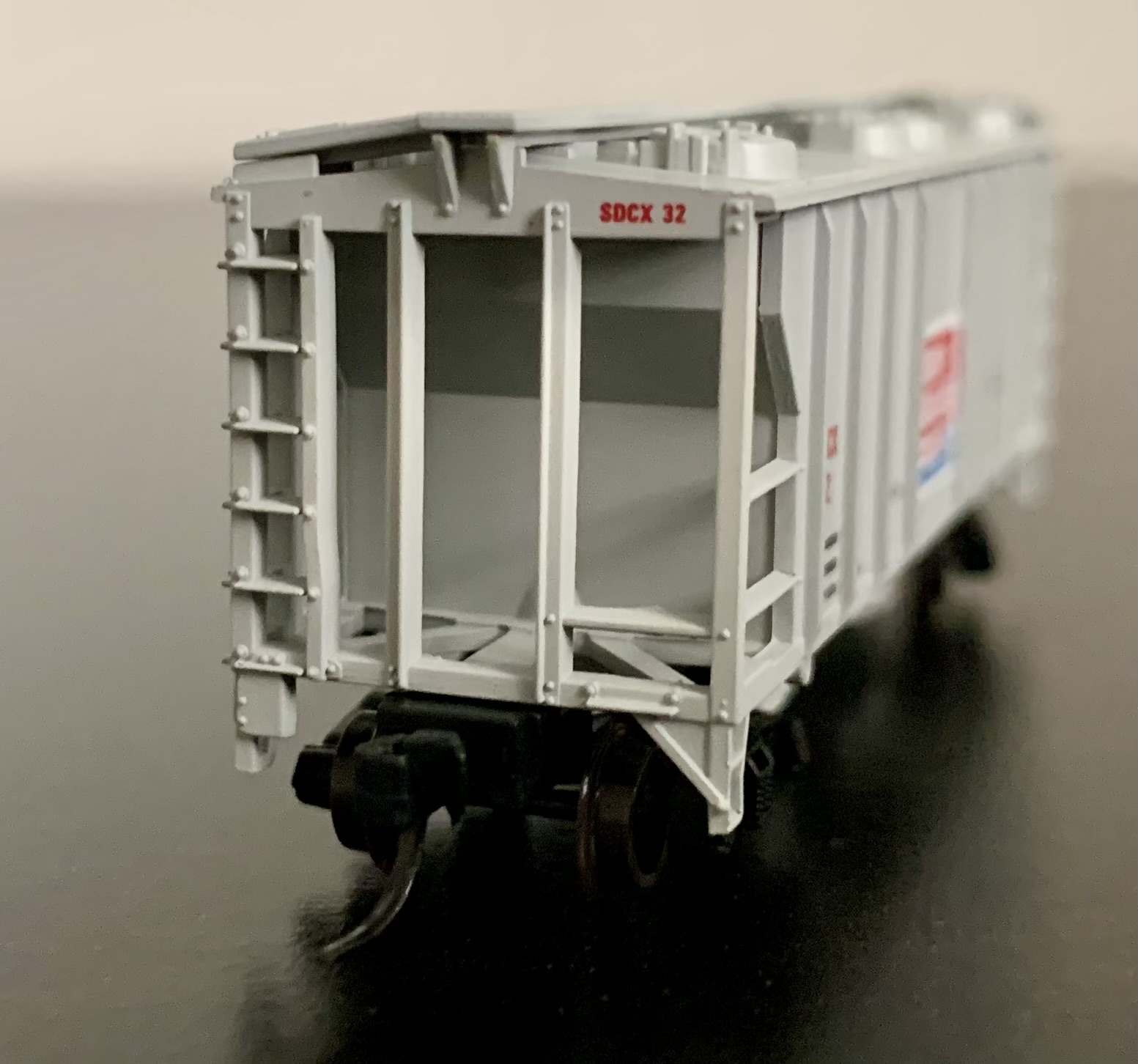
The top of the covered hopper features eight molded round roof hatches for loading product. Along the entire length of the hopper is an overhanging Apex Tri-Lok running board with end latitudinals and molded grab irons. The top displays the prototypical correct ten-panel welded pattern.
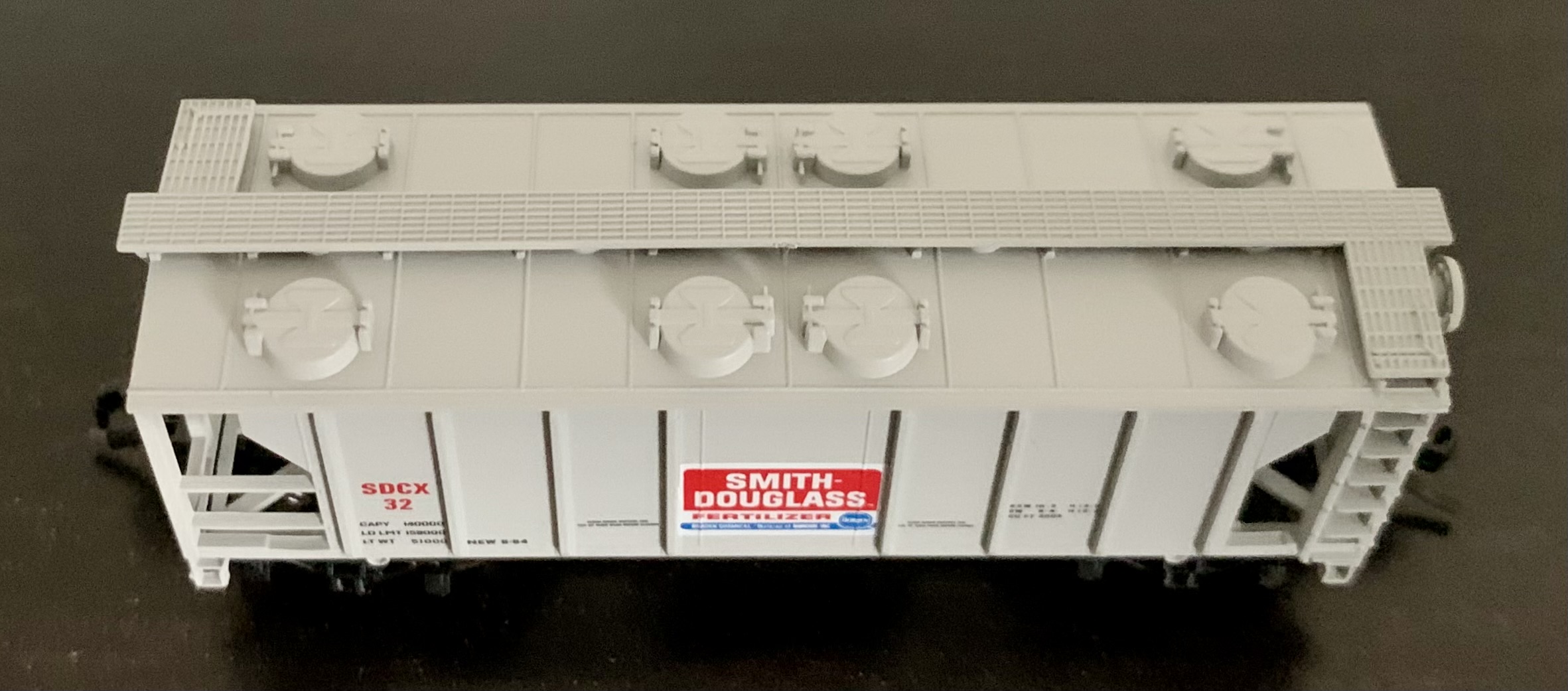
The underside displays two discharge outlet gates with molded details. The model is equipped with truck-mounted AccuMate® couplers installed at the correct height at each end. Atlas has supplied either 50-ton friction bearing or 70-ton roller bearing trucks, where appropriate by road name, with brown plastic wheel sets.
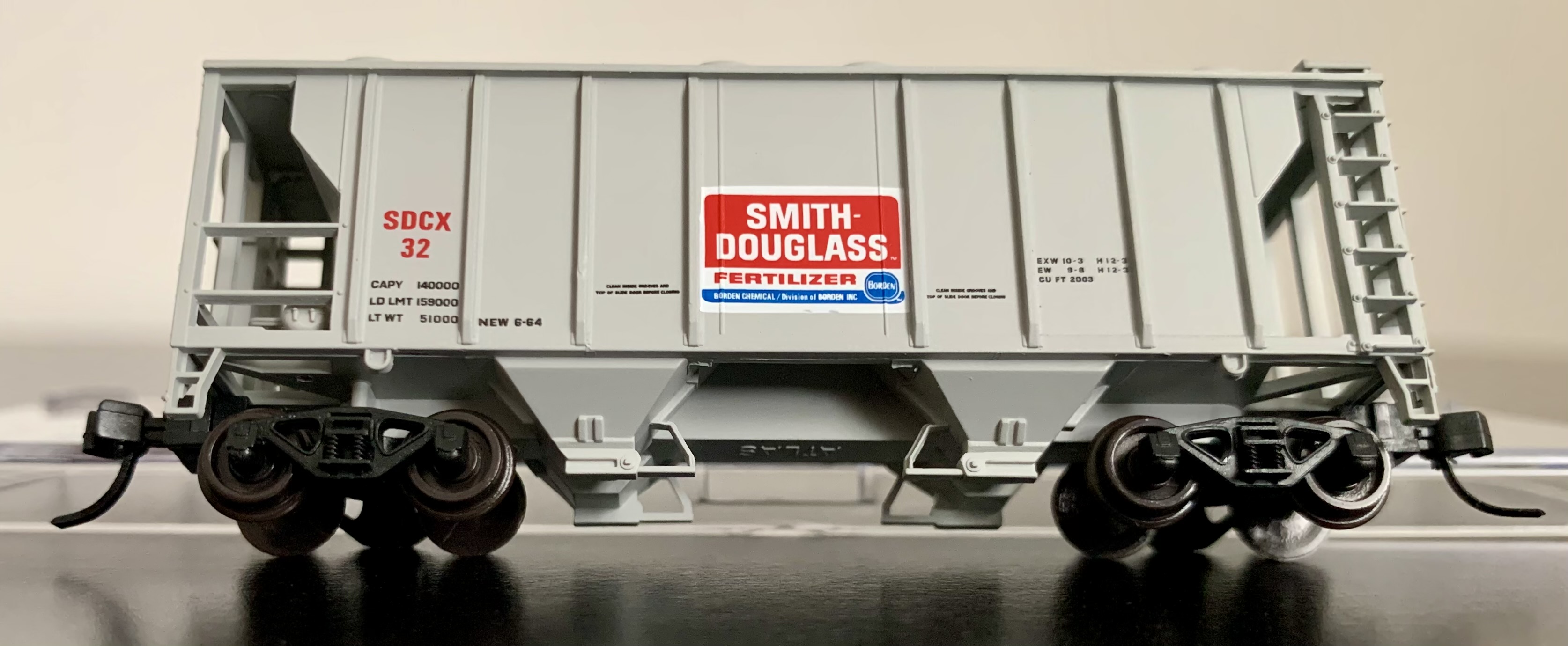
The car measured 2 5/8 inches in length and weighed 0.5 ounces, which is extremely light according to the National Model Railroad Association (NMRA) recommendations of 0.91 ounces for a model of this size. Despite being underweight, I found it a good runner while testing the car on Kato Unitrack with no issues around curves or through turnouts at both slow and medium speeds. The recommended minimum operating radius is 9 3⁄4".
In short, no sour milk here. You get what is advertised – a well-built model with an excellent paint and lettering job. Solid runner with interesting road schemes that’s priced right. On the other hand, for the shrewd collector, the underweight model is produced with molded, oversized detail parts…toss in the non-prototypical post design, ejector pin marks, and brown plastic wheels and he/she may be underwhelmed. But don’t a have cow man – the Trainman Series is for those looking for Atlas Model Railroad quality without breaking the bank.
To Explore More of the Atlas PS-2 Covered Hopper Product Line: CLICK HERE
Photo Credits:
Highsmith, C. M., photographer. (2014) Classic "Elsie the Cow" advertising sign at a still-operating Borden's Dairy plant in Dallas, Texas. Dallas United States Texas, 2014. -05-18. [Photograph] Retrieved from the Library of Congress,No known restrictions on publication.Leet, F. F. (ca. 1910) Borden's Condensery, Randolph, N.Y. New York Randolph United States New York State, ca. 1910. [Photograph] Retrieved from the Library of Congress, No known restrictions on publication.
Historic American Engineering Record, Creator, S. S Beman, Nathan F Barrett, Pullman Palace Car Company, George M Pullman, Allen Paper Car Wheel Company, Pullman Land Association, et al. Pullman Industrial Complex, 111th Street & Cottage Grove Avenue vicinity, Chicago, Cook County, IL. Cook County Illinois Chicago, 1968. Documentation Compiled After. Photograph. No known restrictions on images made by the U.S. Government.

